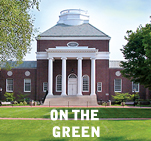
![]()

Bone marrow drive yields gift of life

![]()

Bone marrow drive yields gift of life
Two years is a long time to wait for good news, so when it came to light that a bone marrow drive held on campus in December 2004 had resulted in a donor match, Karla Boyd, AS ’07, says she took a minute to react.
Then a sophomore active in UD’s chapter of Hillel, Boyd had organized the drive and generated campus publicity for it after learning about the Gift of Life Foundation, a nonprofit organization that collects and registers bone marrow samples from possible donors. But, like a true philanthropist, she’d soon forgotten her efforts.
“I’d heard about Gift of Life and was interested in what they did,” Boyd, a biology major, says. “They want to get as many people as possible into their registry but focus on the Jewish community in particular, because so many bloodlines were cut during the Holocaust.” As a result, she says, Ashkenazi Jews who need bone marrow have a harder time finding matching donors.
After she learned how samples are collected for donor matches—a cheek swab rather than a finger stick—Boyd says that holding a drive on campus “seemed too easy and too important not to do.”
When word arrived by e-mail on Feb. 16 that former UD student and drive participant Pauline La Bella had donated two liters of bone marrow, that importance became particularly clear, Boyd says. The donation went to a 19-year-old girl with aplastic anemia who had been through chemotherapy and several infections before her match was found.
La Bella, now a senior nursing student at the State University of New York at Orange, says she remembers seeing a flier about the drive and deciding to register. “I totally forgot about it until last year when I was contacted to be a donor,” she says.
That match later fell through, but La Bella, whose AB-positive blood contains markers and antibodies that are in high demand, was called again. On Feb. 13, she went into surgery at a New York City hospital, where two incisions were made at the base of her spine.
“It was painful, but it was worth it,” La Bella, who knows nothing about her bone marrow recipient other than her age, gender and condition, says. “I have a little sister who is the same age as my recipient, and I think about all the things she’s doing right now and how happy she is and how terrible it must be to be sick. So many people who hear about what I’ve done say, ‘You’re so brave,’ or ‘You’re such a hero,’ but that’s not it. How could I not do it?”
Although she hopes to meet the recipient in the future, La Bella says, that would be icing on the cake and nothing she really expects. “If she wants to meet me in a year, she can, but it’s really up to her. I just feel good having had the chance to give someone else a chance,” she says.
“My contact at Gift of Life said, ‘You only get to do this one or two times in your life, and most people never get to do it.’ Most samples are kept in the bank until the donor turns 62, and they never make matches. I was called twice.”
The Gift of Life Bone Marrow Foundation was established in 1991 to recruit potential donors who might help save the life of New Jersey leukemia patient Jay Feinberg. Over the next five years, the nonprofit organization launched an ambitious grassroots campaign to recruit donors of Eastern-European Jewish ethnicity throughout North America and abroad.
By 1995, 60,000 donors had registered with the National Marrow Donor Program in the United States, as well as other national registries in Canada, Israel and
many other countries, through Gift of Life’s campaign. Also in that year, a match was found for Feinberg, who received a successful transplant.